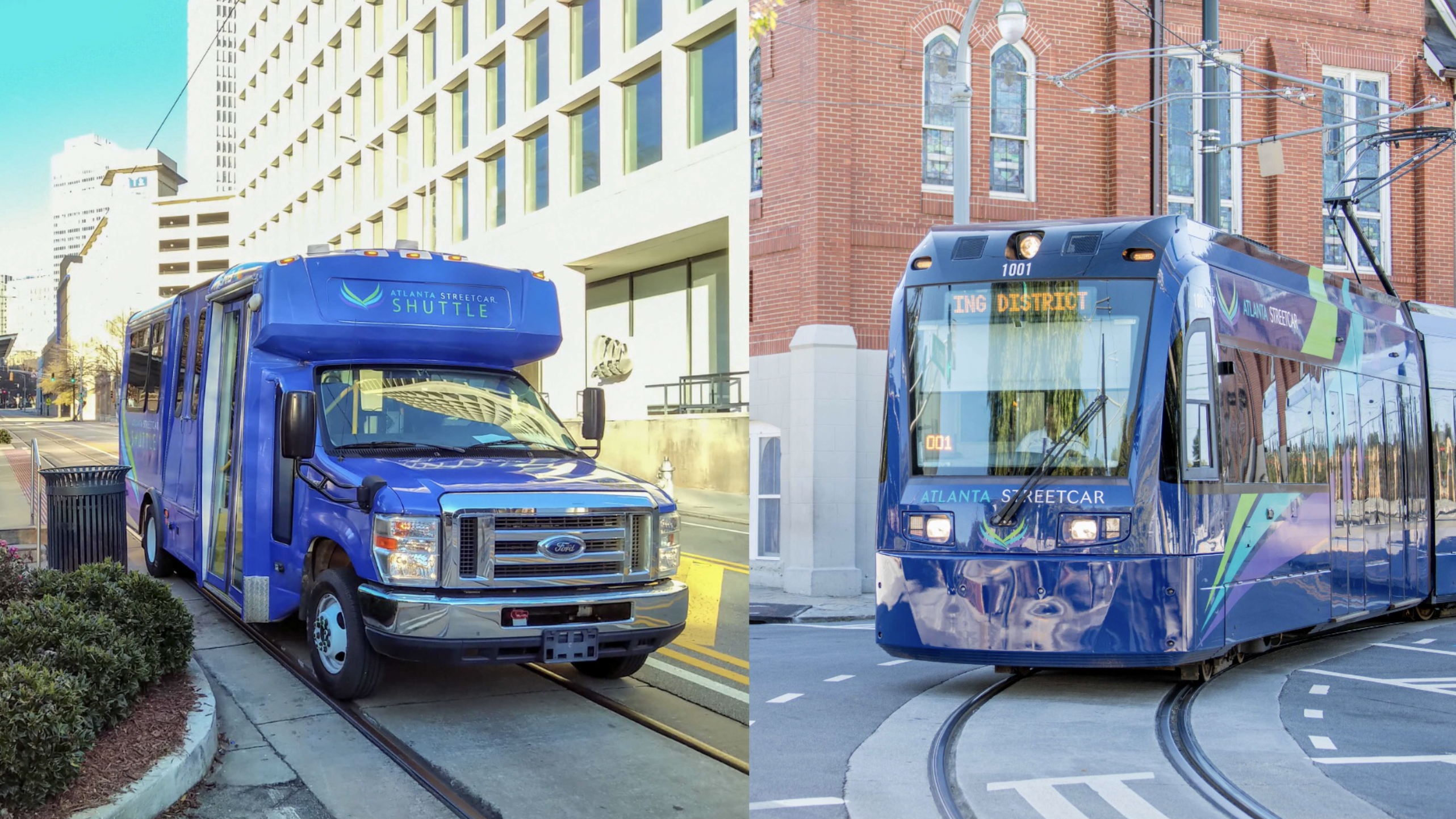
Transit Briefs: MARTA, NYMTA, WMATA
Written by Marybeth Luczak, Executive Editor
As MARTA’s streetcar vehicle wheels are being replaced due to degradation, shuttle vans wrapped to look like streetcars are servicing the Atlanta, Ga., route. (MARTA Photographs)
Streetcar service is returning to downtown Atlanta, Ga., reports Metropolitan Atlanta Rapid Transit Authority (MARTA). Also, New York Metropolitan Transportation Authority (MTA) will upgrade accessibility at 17 subway stations across all five boroughs; and Washington Metropolitan Area Transit Authority (WMATA) is eyeing design changes for its new 8000-series rapid transit cars.
The first of the repaired Atlanta Streetcar vehicles will be on the streets for testing starting Feb. 28, according to MARTA. It is expected that they will enter regular service on March 2. The rest of the vehicles will follow as repairs are made.

MARTA on Nov. 29, 2022, removed the four streetcar vehicles “after engineers discovered wheel degradation that could pose a safety risk”; the wheels on the first vehicle have now been replaced and the wheels on the three others will be replaced “in the coming weeks,” MARTA reported on Feb. 23.
The cost of the replacement wheels is approximately $400,000 and being paid through MARTA’s capital budget, the Authority said.
MARTA shuttle vans, wrapped to look like streetcars, will continue servicing the route as the streetcar vehicles return. The streetcar route connects the Martin Luther King Jr. National Historic Site to the east and the Centennial Olympic Park area to the west, with 10 other stops in between.
“I want to commend our engineers for immediately making the decision to pull these vehicles so repairs could be made,” MARTA Chief Operating Officer George Wright said. “We are going to test out the new wheels so you will see the streetcar along its route for a few days before it returns to service.”

New York MTA on Feb. 23 reported that it will upgrade accessibility at 17 New York City Transit and Staten Island Railway (SIR) stations with the installation of 29 new elevators. The stations are scheduled for contract award this year.
“The 2020-2024 Capital Program is the most ambitious accessibility program in MTA history, with $5.2 billion to make 67 stations accessible—more than the previous three Capital Programs combined,” MTA said. “In 2022, contracts were awarded for 13 new stations, including eight stations as part of the agency’s first Public-Private Partnership package. As a result, the MTA is currently in construction at 34 stations throughout the system.”
In 2023, the MTA intends to award ADA station upgrades at these stations: Van Cortlandt Park-242nd Street; Harlem-148th Street; 96th Street; 81st Street; 86th Street; 46th Street-Bliss Street; 33 Street-Rawson; Broadway; Court Square-23 Street; New Lots Avenue; Classon Avenue; 36 Street; Huguenot (SIR); 168 Street; and Broadway Junction (three stations).
“More elevators and ramps, spread throughout the subway system creates a mass transit system that is open to everyone,” MTA Chief Accessibility Officer Quemuel Arroyo said. “A large number of riders with disabilities, customers with children in strollers, and visitors with luggage will benefit by being able to get to work, school and entertainment easily.”
The Washington Post on Feb. 23 reported that WMATA is considering an open gangway design for its 8000 series cars from Hitachi Rail, which will be assembled at a new 307,000-square-foot Maryland plant starting next year.
“There are very significant advantages, especially for the accessibility community for safer [transport],” WMATA General Manager Randy Clarke said during a WMATA Board meeting Feb. 23, according to the newspaper. “It provides a lot more flexibility on heavy crowded days, special event management, better potential flow for things like bikes and strollers and … luggage with another airport that we serve,” he said, referring to the new station that opened last year at Dulles International Airport.
“The shift, Clarke said, is intended to modernize Metro [WMATA] and get it in step with transit systems in Europe and Asia, as well as New York, which is scheduled to incorporate a pilot of open-gangway subway cars [from Kawasaki] into its fleet this spring,” the paper reported.
WMATA in 2021 awarded Hitachi a contract to design and build an initial order of 256 8000-series rapid transit cars, which will replace aging 2000- and 3000-series cars that have been in service since the early 1980s and were manufactured by Italian firm Breda (now Hitachi Rail Italy). If all options in the contract are exercised, a total of 800 cars will be supplied to the agency, worth up to $2.2 billion. Hitachi also announced in 2021 it would manufacture the car body structure, fit out the trains, and carry out final assembly at a new Washington, D.C., area plant, and in October 2022 released final designs for the $70 million facility and test track to be built in Maryland. WMATA’s new cars will be first on the production line when it opens in early 2024.
The new railcar design proposal is the latest WMATA “has considered or launched during a three-year span that has included revamped station platforms with video screens and improved digital arrival signs, mobile fare cards and a touchless fare payment system,” according to The Washington Post. The Authority “is also trying to attract new passengers since the widespread adoption of telecommuting cut ridership by about half.”



